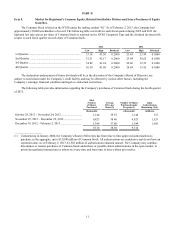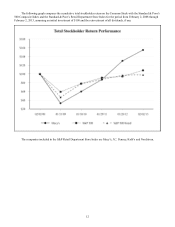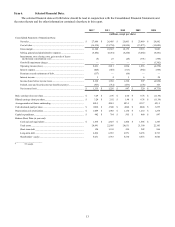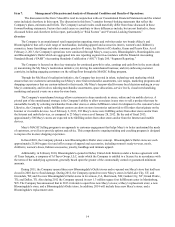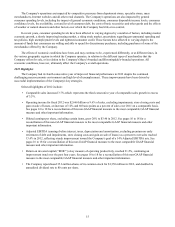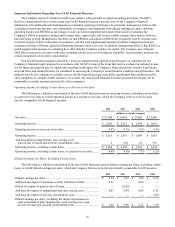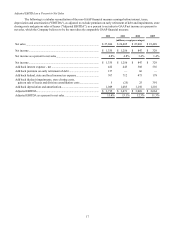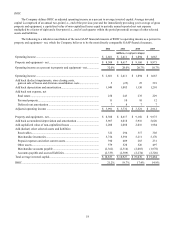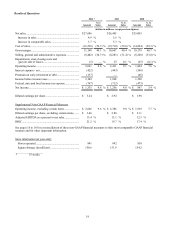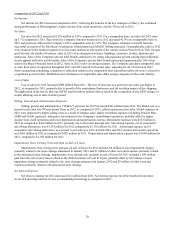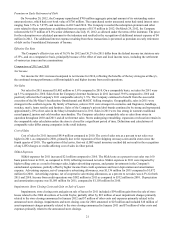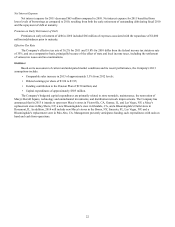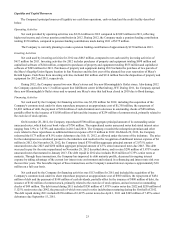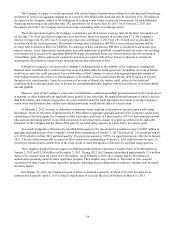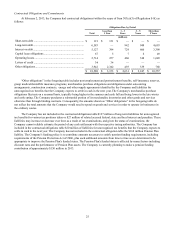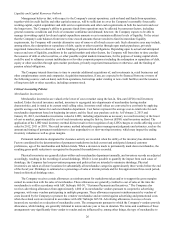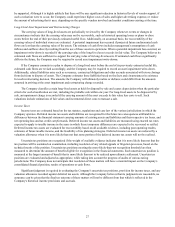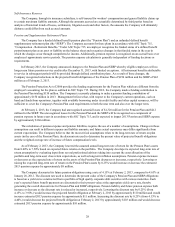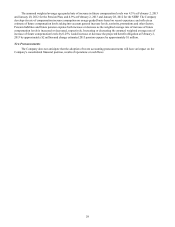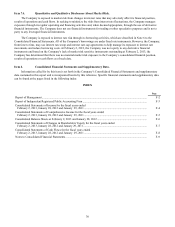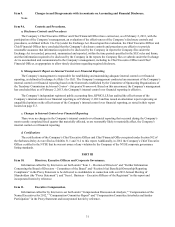Macy's 2012 Annual Report Download - page 26
Download and view the complete annual report
Please find page 26 of the 2012 Macy's annual report below. You can navigate through the pages in the report by either clicking on the pages listed below, or by using the keyword search tool below to find specific information within the annual report.
21
Premium on Early Retirement of Debt
On November 28, 2012, the Company repurchased $700 million aggregate principal amount of its outstanding senior
unsecured notes, which had a net book value of $706 million. The repurchased senior unsecured notes had stated interest rates
ranging from 5.9% to 7.875% and maturities in 2015 and 2016. The Company recorded the redemption premium and other
costs related to these repurchases as additional interest expense of $133 million in 2012. On March 29, 2012, the Company
redeemed the $173 million of 8.0% senior debentures due July 15, 2012, as allowed under the terms of the indenture. The price
for the redemption was calculated pursuant to the indenture and resulted in the recognition of additional interest expense of $4
million in 2012. The additional interest expense resulting from these transactions is presented as premium on early retirement
of debt on the Consolidated Statements of Income.
Effective Tax Rate
The Company's effective tax rate of 36.5% for 2012 and 36.2% for 2011 differ from the federal income tax statutory rate
of 35%, and on a comparative basis, principally because of the effect of state and local income taxes, including the settlement
of various tax issues and tax examinations.
Comparison of 2011 and 2010
Net Income
Net income for 2011 increased compared to net income for 2010, reflecting the benefits of the key strategies at Macy's,
the continued strong performance at Bloomingdale's and higher income from credit operations.
Net Sales
Net sales for 2011 increased $1,402 million or 5.6% compared to 2010. On a comparable basis, net sales for 2011 were
up 5.3% compared to 2010. Sales from the Company's Internet businesses in 2011 increased 39.6% compared to 2010 and
positively affected the Company's 2011 comparable sales by 1.5%. The Company continued to benefit from the successful
execution of the My Macy's localization, Omnichannel and MAGIC Selling strategies. Geographically, sales in 2011 were
strongest in the southern regions. By family of business, sales in 2011 were strongest in cosmetics and fragrances, handbags,
watches, men's, home textiles and furniture. Sales of the Company's private label brands continued to be strong and represented
approximately 20% of net sales in the Macy's-branded stores in 2011. Sales in 2011 were less strong in women's traditional
casual apparel, juniors and cold weather merchandise. The Company calculates comparable sales as sales from stores in
operation throughout 2010 and 2011 and all net Internet sales. Stores undergoing remodeling, expansion or relocation remain in
the comparable sales calculation unless the store is closed for a significant period of time. Definitions and calculations of
comparable sales differ among companies in the retail industry.
Cost of Sales
Cost of sales for 2011 increased $914 million compared to 2010. The cost of sales rate as a percent to net sales was
higher in 2011, as compared to 2010, primarily due to the expansion of free shipping on macys.com and in stores since the
fourth quarter of 2010. The application of the last-in, first-out (LIFO) retail inventory method did not result in the recognition
of any LIFO charges or credits affecting cost of sales in either period.
SG&A Expenses
SG&A expenses for 2011 increased $21 million compared to 2010. The SG&A rate as a percent to net sales was 160
basis points lower in 2011, as compared to 2010, reflecting increased net sales. SG&A expenses in 2011 were impacted by
higher selling costs as a result of stronger sales, higher advertising expense, and greater investments in the Company's
omnichannel operations, partially offset by higher income from credit operations and lower depreciation and amortization
expense. Advertising expense, net of cooperative advertising allowances, was $1,136 million for 2011 compared to $1,072
million for 2010. Advertising expense, net of cooperative advertising allowances, as a percent to net sales was 4.3% for both
2011 and 2010. Income from credit operations was $582 million in 2011 as compared to $332 million in 2010. Depreciation
and amortization expense was $1,085 million for 2011, compared to $1,150 million for 2010.
Impairments, Store Closing Costs and Gain on Sale of Leases
Impairments, store closing costs and gain on sale of leases for 2011 included a $54 million gain from the sale of store
leases related to the 2006 divestiture of Lord & Taylor, partially offset by $22 million of asset impairment charges primarily
related to the store closings announced in January 2012 and $7 million of other costs and expenses primarily related to the
announced store closings. Impairments and store closing costs for 2010 amounted to $25 million and included $18 million of
asset impairment charges primarily related to the store closings announced in January 2011 and $7 million of other costs and
expenses primarily related to the announced store closings.


